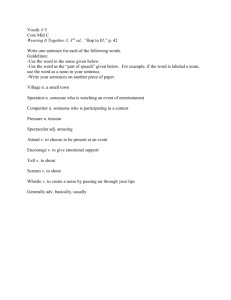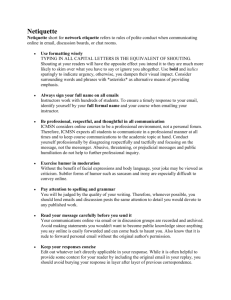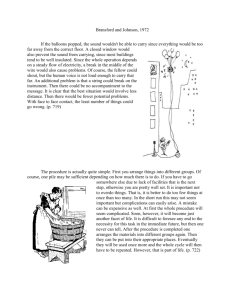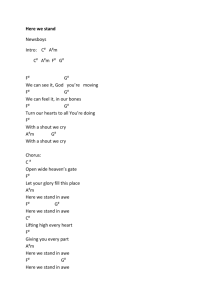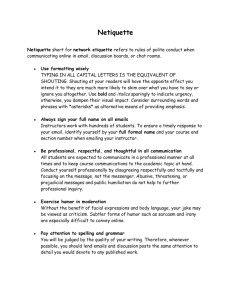as t - Department of Mathematics - Hong Kong University of Science
advertisement
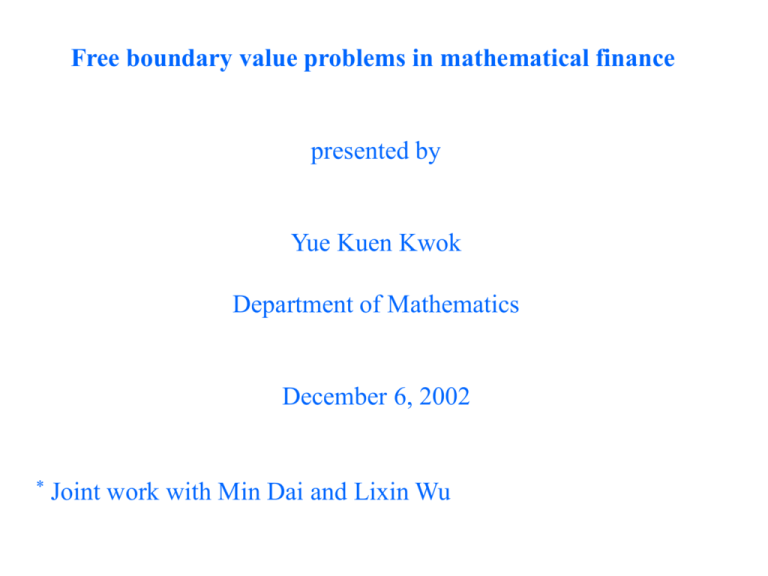
Free boundary value problems in mathematical finance presented by Yue Kuen Kwok Department of Mathematics December 6, 2002 * Joint work with Min Dai and Lixin Wu Rocket science on Wall Street • The volatility of stock price returns is related to the viscosity effect in molecular diffusion. • The expected rate of returns is related to convective velocity. The option pricing equation is closely related to the convective diffusion equation in engineering. Brownian motion was first studies in theoretical aspects by Bachelier (1900) in the modeling of stock price movements, a few years earlier than Einstein (1905). OPTIMAL SHOUTING POLICIES OF OPTIONS WITH RESET RIGHTS presented by Yue Kuen Kwok Hong Kong University of Science and Technology at International Conference on Applied Statistics, Actuarial Science and Financial Mathematics December 17-19, 2002 * Joint work with Min Dai and Lixin Wu The holders are allowed to reset certain terms of the derivative contract according to some pre-specified rules. Terms that are resettable • strike prices • maturities Voluntary (shouting) or automatic resets; other constraints on resets may apply. Examples 1. S & P 500 index bear market put warrants with a 3-month reset (started to trade in 1996 in CBOE and NYSE) - original exercise price of the warrant, X = closing index level on issue date - exercise price is reset at the closing index level St on the reset date if St > X (automatic reset) Reset-strike warrants are available in Hong Kong and Taiwan markets. 2. Reset feature in Japanese convertible bonds • reset downward on the conversion price Sumitomo Banks 0.75% due 2001 Issue date May 96 First reset date 31 May 1997 Annual reset date thereafter 31 May Reset calculation period Calculation type 20 business day period, excluding holidays in Japan, ending 15 trading days before the reset day Simple average over calculation period 3. Executive stock options • resetting the strike price and maturity 4. Corporate debts • strong incentive for debtholders to extend the maturity of a defaulting debt if there are liquidation costs 5. Canadian segregated fund - Guarantee on the return of the fund (protective floor); guarantee level is simply the strike price of the embedded put. - Two opportunities to reset per year (at any time in the year) for 10 years. Multiple resets may involve sequentially reduced guarantee levels. - Resets may require certain fees. Objectives of our work Examine the optimal shouting policies of options with voluntary reset rights. Free boundary value problems • • Critical asset price level to shout; Characterization of the optimal shouting boundary for one-shout and multi-shout models (analytic formulas, numerical calculations and theoretical analyses) Resettable put option The strike price is reset to be the prevailing asset price at the shouting moment chosen by the holder. max (X ST ,0) if no shout occurs Terminal payoff max (S t ST ,0) if shouting occurs at time t Shout call option max (ST X,St X ) if shouting occurs at time t , St X Terminal payoff if no shout occurs max (ST X ,0) Shout floor (protective floor is not set at inception) Shout to install a protective floor on the return of the asset. max (S t ST ,0) if shouting occurs at time t Terminal payoff 0 if no shout occurs Relation between the resettable put option and the shout call option Since max( ST X , St X ) ( ST X ) max( ST X ,0) max( X ST ,0) , max( St ST ,0) so price of one-shout shout-call option = price of one-shout resettable put option + forward contract. • Both options share the same optimal shouting policy. • Same conclusion applied to multi-shout options. Formulation as free boundary value problems • Both one-shout resettable put option and one-shout shout floor become an at-the-money put option upon shouting. • Price function of an at-the-money put option is SP1(t), where P1 (t ) e rt N (d 2 ) e qt N (d1 ) 2 r q 2 d1 t and d 2 d1 t . where Linear complementarity formulation of the pricing function V(S, t) V 2 2 2V V S (r q) S rV 0, V ( S ,t ) SP1 (t ), 2 t 2 S t V 2 2 2V V S (r q) S rV V SP1 (t ) 0 2 2 S S t max( X S ,0) for resettable put V ( S ,0) . 0 for shout floor Properties of P1(t) (i) If r q, then d qt e P1 (t ) 0 for t (0, ). dt (ii) If r > q, then there exists a unique critical value t 1 (0, ) such that d qt e P1 (t ) t t 0, 1 dt and d qt e P1 (t ) 0 for t (0, t 1 ) dt d qt e P1 (t ) 0 for t (t 1 , ) dt eqtP (t) | eqtP1(t) 1 rq t r>q t *1 t Price of the one-shout shout floor, R1(S, t) R1 (S ,t ) S g (t ) Substituting into the linear complementarity formulation: d qt e q(t ) 0, g (t ) P1 (t ) dt d qt e g (t ) g (t ) P1 (t ) 0 dt g (0) 0. (i) r q d qt e P1 (t ) 0 for t 0 and P1 (0) 0; dt so g (t ) P1 (t ), t (0, ). (ii) r > q g (t ) P1 (t ) for t (0,t1 ]. When t > t *1 , we cannot have g(t) = P1(t) since this leads to d qt d qt e g (t ) e P1 (t ) 0, dt dt a contradiction. Hence, d qt e g (t ) 0 for t (t 1 , ). dt Solving g (t ) e q (t t1 ) P1 (t1 ) for t (t1 , ). * eq(t t1) P1(t 1 ) g(t) P1(t) t t *1 Optimal shouting policy of the shout floor • does not depend on the asset price level (due to linear homogeneity in S) • d qt when e P1 (t ) 0, R1 ( S ,t ) SP1 (t ) , dt inferring that the holder should shout at once. Summary (i) r q, t (0, ) or (ii) r > q, t t*1 holder should shout at once (ii) r > q, t t*1 holder should not shout at any asset price level. Optimal shouting boundary for the reset put option Asymptotic behavior of S*(t) as t 0+ 1 S1*(0+) Proof = X, independent of the ratio of r and q. D1 ( S , t ) V1 ( S , t ) SP1 (t ) D1 2 2 2 D1 D1 ' (t ) qP (t ) S ( r q ) S rD S P 1 1 1 t 2 S 2 S 0 S S1 (t ), t 0 D1 (0, t ) Xe rt and D1 ( S1 (t ), t ) 0 D1 ( S1 (t ), t ) 0, D1 ( S ,0) max( X S ,0). S Note that D1(S, t) 0 for all t; S[P(t) + qP1(t)] as t 0+. 1 * + Assuming S1(0 ) > X, then for S (X, S*1(0+)), we have D1 ( S ,0 ) S P1' (t ) qP1 (0) 0, a contradiction. t Financial intuition dictates that S1*(0+) X. Asymptotic behaviour of S1*(t) as t S*1, exists when r < q; this is linked with the existence of the limit: et e lim P1 (t ) 1 for r < q. t Write W1 ( S ,t ) e rt V ( S ,t ); W1 ( S ) lim W1 ( S ,t ). t 2 2 d W dW 1 1 S2 ( r q ) S 0 , 0 S S 1, 2 dS 2 dS W1 (0) X , W1 ( S1, ) S1, , dW1 ( S1, ) 1. dS 1 W1 ( S ) X X S , 1 (1 ) 0 S S1, , 1 2(q r ) where S1. 1 X and ( becomes zero when r = q). 2 When r > q, V1(S, t) R1(S, t) > SP1(t) for t > t*1. It is never optimal to shout at t > t*1. Lemma For r > q and t0 < t*1, there exists a critical asset price S1*(t0) such that V1(S, t0) = SP1(t0) for S1 S*(t0). Integral equation for S1*(t) S (t ) P1 (t ) PE ( S (t ), t ) S (t )e 1 1 1 qt t 0 1.t u N (d d qu ) [e P1 (u )] du du where 1,t u d ln S1 (t ) S1 ( u ) r q 2 t u 2 )(t u) . Pricing formulation of the n-shout resettable put option Terminal payoff max( St ST ,0 ),where t is the last shouting instant, 0 n. Define Pn (t ) Vn 1 (1,t ; X 1), then Vn 2 2 2Vn Vn S (r q) S rVn 0, Vn ( S ,t ) SPn (t ), t 2 S 2 S Vn Vn 2 2 2Vn Vn SPn (t ) 0 S ( r q ) S rV t 2 2 S S Vn ( S ,0) max( X S ,0). * The analytic form for Pn(t), n > 1. Properties of the price function and optimal shouting boundaries (i) r < q, S*n(t) is defined for t (0, ) S n1 (t ) S n (t ), n 1,2 S n (0 ) X Sn*(t) is an increasing function of t with a finite asymptotic value as t . 1 1 1 1 S 2, and S . 3, 1 (1 )1 1 (1)1 1 (1)1 (ii) r < q, S*n(t) is defined only for t (0, t*n), where t*n is given by the solution to d qt e Pn (t ) 0. dt Summaries and conclusions • The behaviors of the optimal shouting boundaries of the resettable put options depends on r > q, r = q or r < q. • Monotonic properties (i) an option with more shouting rights outstanding should have higher value; (ii) the holder shouts at a lower critical asset price with more shouting rights outstanding; (iii) the holder chooses to shout at a lower critical asset price for a shorter-lived option; (iv) the critical time earlier than which it is never optimal to shout increases with more shouting rights outstanding. Analytic price formula of the one-shout shout floor and integral representation of the shouting premium of the one-shout resettable put are obtained. •
